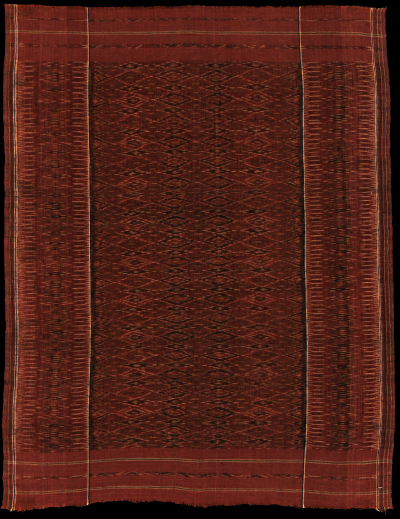| |
 
 | | | |
046 Bali Group, Nusa Penida
Kain cepuk  
| | Locale: | Village unknown. | | Period: | Mid to late 19th c. | | Yarn: | Cotton, hand-spun, fine | | Technique: | Weft ikat | | Panels: | 1 | | Size: | 86 x 111 cm (2' 9" x 3' 7") LW: 1.29 | | Design: | Patola-inspired style design, predominantly ecru on brick red, with russet and faded yellow and green accents. The handspun yarn belongs to the most irregular that we have inspected under the microscope: a jungle of thicker and finer creepers in a variety of rich, vegetable colours that partly blend into one another. A look with the microscope is highly recommended. The yarn of all cloths from the 19th and very early 20th c that we have inspected are far more irregular than that spun in the later parts of the colonial period. Perhaps because hand spun was then competing more directly with commercial thread, and, not to be outdone, weavers began to spin with greater precision. | | Comment: | Well preserved example of and old kamben cepuk, ceremonial hip cloth, made on the island of Nusa Penida off Bali's south coast, for use on Bali. Such cloths were highly valued because seen as highly protective, made as they were on feared Nusa Penida, where evil ruled. Whereas most kamben cepuk, even those from the later parts of the 19th c. were done in aniline dyes, either in whole or largely, the very dark, reddish brown undertone of this cloth and the muted yellow and green make clear that it was made with natural dyes only - probably in morinda, morinda overdyed with indigo, yellow akar kayu kuning, and a vegetable green dye. Of the latter two only traces remain, as the natural yellow and green dyes used here and on Bali are unstable. | | Background: | Chapters on Bali Group and Nusa Penida. | | Published: | Woven Languages, 2014.
Ikat Textiles of the Indonesian Archipelago, 2018.
| | Compare: | 043 124 129 | | Sources: | Basic structure conforms to that of Nusa Penida as shown in Gittinger's To Speak with Cloth, Fig. 14 on p. 188. See also Gittinger, Splendid Symbols, Fig. 106; Khan Majlis,Indonesische Textilien, Wege zu Goettern und Ahnen, Fig. 323 and p.73; Buehler, Patola Influences, Plate 14; Gillow, Traditional Indonesian Textiles, Fig. 73. Similar to early 20th c. example in McIntosh, Thread and Fire, Fig. 3-21. | | |

©Peter ten Hoopen, 2024
All rights reserved.
|
|


